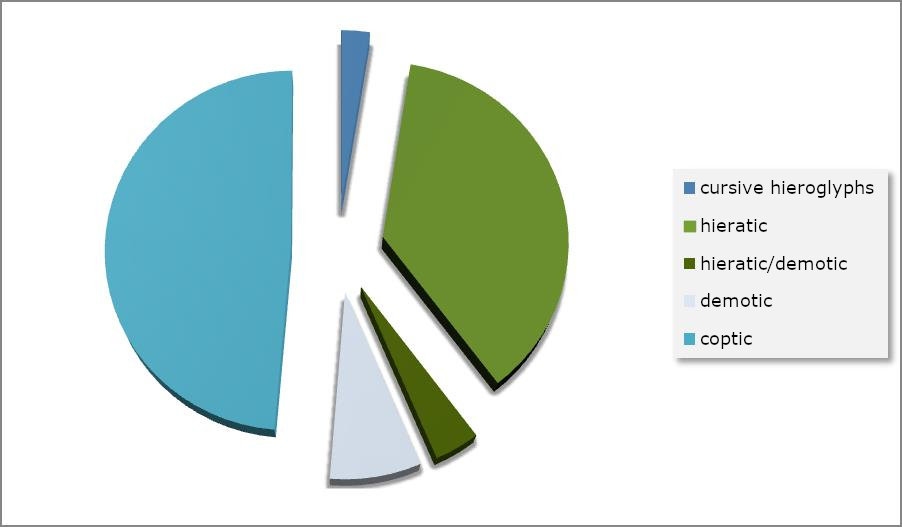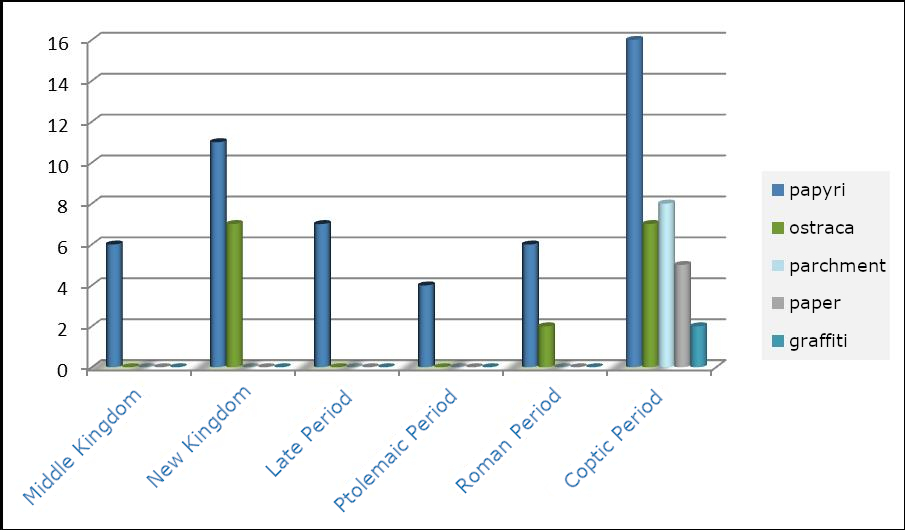Medical science (medicine and curative magic)
Our main sources of medical knowledge and expertise in Ancient Egypt are texts written on papyrus and ostraca (fragments of pottery or limestone). The corpus of these medical texts covers a period from the beginning of the second millennium BC (Middle Kingdom) to the Graeco-Roman Period. The script and language of these differ depending on the date of the text, given the historical development of the ancient Egyptian language. The oldest medical texts were written in cursive hieroglyphs, while the main part of the corpus consists of Hieratic papyri or ostraca. Starting with the first century BC, medical texts were written in Demotic. Manuscripts with different writing systems, such as papyrus Vienna D. 6257, which exhibits both Hieratic and Demotic script, are of particular interest.

Fig. 1: Distribution of the types of script used within the corpus of medical knowledge texts

Fig. 2: Distribution of the text mediums used within the corpus of medical knowledge texts
In general, we distinguish two different types of ancient Egyptian medical text: Specialized volumes were dedicated to just one branch of medical science and present didactic instructions, diagnoses and prescriptions, while compendia assemble texts on different cases of illness from the various medical specialties. The arrangement of the individual texts in these collective volumes can follow a specific medical classification system, but can also lack any underlying structure. Furthermore, texts that are assigned to cross-thematic issues, such as the so-called “Demotic Herbal”, which systematically lists various plants in Egypt, provide further information about the medical knowledge of the ancient Egyptians. This manuscript registers not only the appearance and distribution of individual plants, but also their medical fields of application. Papyrus Brooklyn 47.218.48 & 85, the so-called “Snakebite Papyrus”, is a treatise that systematically describes various types of snakes in Egypt and gives various recipes and healing methods for snake bites. Both texts describe ancient Egyptian healing practice, while providing important information about botany and zoology.
Diverse areas of medicine are documented within the medical texts: we have recipes for vascular treatments, gynaecology (gynaecological disorders, contraception ...) in close connection with paediatrics, surgery, remedies for the treatment of the body, remedies for snake bites, veterinary medicine, didactic texts concerning stomach diseases, ophthalmology and tumours.
The format of these texts provides us with information about the usability and context of the use of the medical papyri: The so-called half-size format with a height of around 15 cm is much easier to handle than a format with a height of around 30 cm. Medical papyri can also be considered as everyday manuals, as the papyrus roll was provided with an empty flyleaf, similar to the dust cover of modern books, and the content was protected by a generous upper and lower margin. The (secondary) addition of gloss-like comments, which explain individual words or groups of words in more detail, demonstrates that the application of the described recipes and didactic texts had already been tested and approved. Finally, a known or reconstructed archaeological context can provide further information about the original practical use of the texts. The Ramesseum papyri, for example, were found together with several objects that could have belonged to the professional equipment of a practicing healer.
